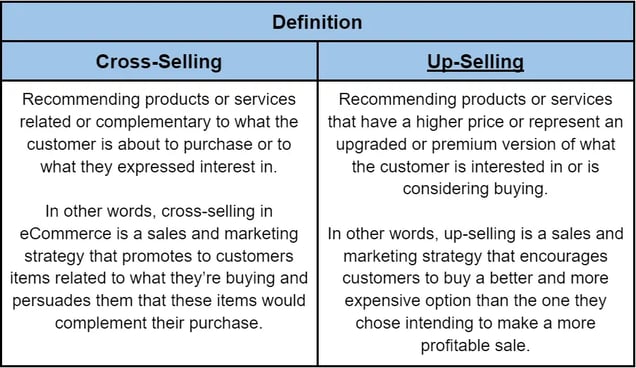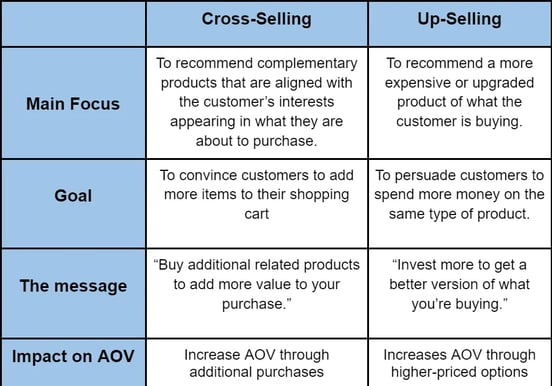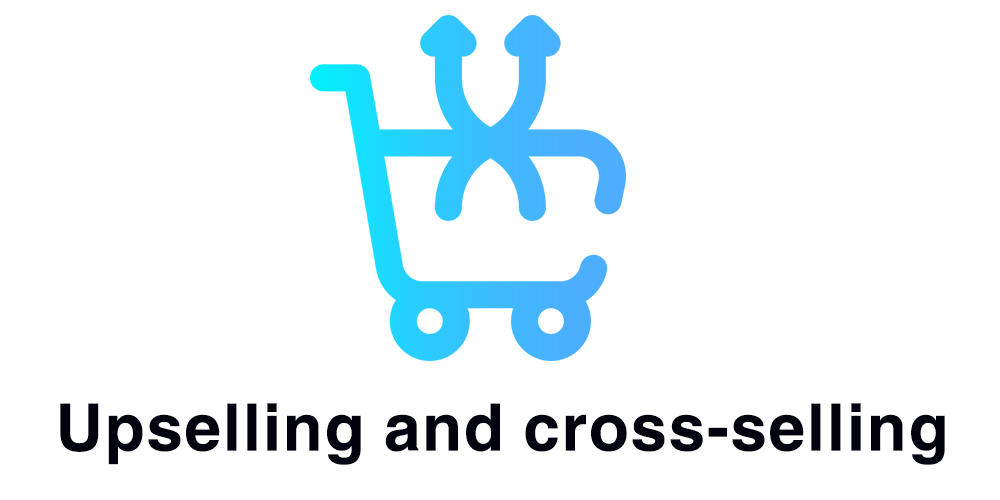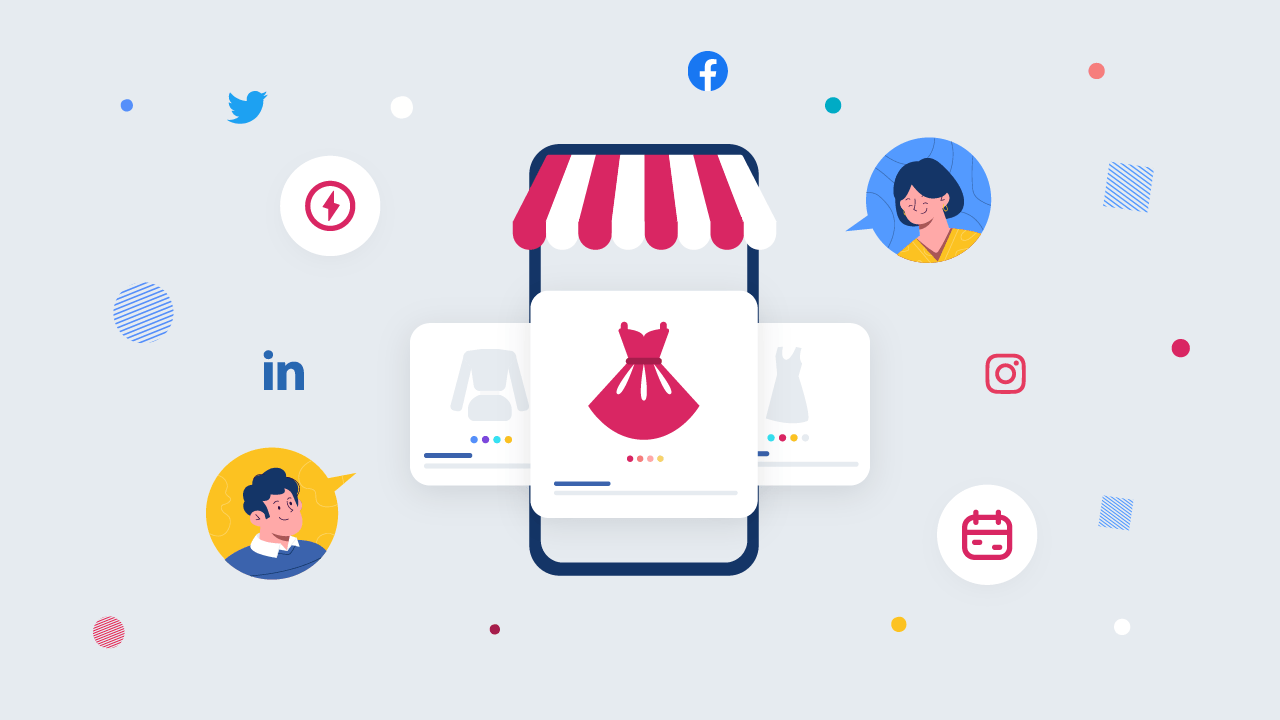The Ultimate Comparison: Cross-Selling vs. Up-Selling
Online shoppers want to see you make an effort to satisfy them, and in such a highly competitive sector, an eCommerce store must constantly work on maximizing that effort. One way you can show your customers that you are constantly thinking about them and taking notes of their interests, preferences, and behaviors is through product recommendations.
Product recommendations can take many different forms. In this article, we will present a comparison between two of the most commonly used strategies of product recommendation: Cross-Selling and Up-Selling.
This comparison will provide you with an exhaustive comparison that includes the definition of both strategies, their similarities and differences, and their benefits. More importantly, this article will help you know which strategy to use for your store. Keep reading to learn all of that.
Table of content: :
- Definition of Cross-Selling and Up-Selling in E-Commerce
- Vital Statistics About Cross-Selling and Up-Selling For E-Commerce.
- Benefits of Cross-Selling vs. Benefits of Up-Selling For E-Commerce.
- When To Use Cross-Selling vs. When To Use Up-Selling.
- Which one is best for your eCommerce store?
Cross-Selling vs. Up-Selling (Full Comparison)
Cross-Selling vs. Up-Selling: The Definition
 Image source: tradexa
Image source: tradexa
- Cross-Selling Definition: Cross-Selling is defined as recommending products or services related or complementary to what the customer is about to purchase or to what they expressed interest in. In other words, cross-selling in eCommerce is a sales and marketing strategy that promotes to customers items related to what they’re buying and persuades them that these items would complement their purchase.
- Up-Selling Definition: Up-Selling is defined as recommending products or services that have a higher price or represent an upgraded or premium version of what the customer is interested in or is considering buying. In other words, up-selling is a sales and marketing strategy that encourages customers to buy a better and more expensive option than the one they chose intending to make a more profitable sale.
A hypothetical example to understand the difference between Cross-Selling and Up-Selling:
Let’s imagine you have an eCommerce store that sells clothes. You get a customer that adds a $50 simple black jacket to their shopping cart.
If you recommend to that customer a $20 white shirt and a $30 pair of pants that go well with that jacket, that’s called “Cross-Selling.”
However, if you recommend to the customer another black jacket that is double-faced with one fur face and the other waterproof and that costs $150, that’s called “Up-Selling.”

Before moving on, there are a few more differences between Cross-Selling and Up-Selling that we want to highlight for a better understanding of how much they differ.
- The main focus of Cross-Selling is to recommend complementary products that are aligned with the customer’s interests appearing in what they are about to purchase, while the main focus of Up-Selling is to recommend a more expensive or upgraded product of what the customer is buying.
- The goal of Cross-Selling is to convince customers to add more items to their shopping cart, while the purpose of Up-Selling is to persuade customers to spend more money on the same type of product.
- Cross-Selling conveys the message: “Buy additional related products to add more value to your purchase,” while Up-Selling conveys the message: “Invest more to get a better version of what you’re buying.”
- Both Cross-Selling and Up-Selling positively impact the Average Order Value (AOV). Cross-Selling does that through additional purchases, while Up-Selling does that through higher-priced options.

Cross-Selling vs. Up-Selling For E-Commerce: Vital Statistics
General Statistics:
- Research shows that 74% of customers are more likely to return to a business if they have had a positive cross-selling or upselling experience (Zendesk, 2022).
- Additionally, around three-quarters of salespeople who use up-selling and 74% of those who use cross-selling say it accounts for 30% of their revenues (HubSpot, 2022).
- In 2020, 80% of e-commerce businesses in the United States said they were using cross-selling and upselling as means to increase sales (Gitnux, 2023).
- Around 10 to 30% of eCommerce revenues come from cross-selling (Gitnux, 2023).
- Businesses that adopt cross-selling can experience from 30% to 50% increase in customer lifetime value (CLV) (Gitnux, 2023).
- Cross-selling can boost sales by 20% and increase profits by 30% (Funnel Strategist, 2023).
- Around 72% of sales professionals who use up-selling say that it drives 1-30% of their business's revenue (HubSpot, 2022).
- Up-selling can yield a 41% increase in average order value (AOV) (HubSpot, 2022).
- Around 70-95% of business revenue comes from upsells and renewals on average (Super Office, 2022).
Cross-Selling vs. Up-Selling: Benefits For E-Commerce
 The benefits of cross-selling and up-selling are not completely distinct. At the end of the day, both strategies would lead to an increase in revenues, profits, return on investment, customer lifetime value (CLV), customer loyalty, and customer satisfaction. In other words, both strategies can help your eCommerce brand provide an exceptional customer experience. However, each yields some results more directly than the other, which is illustrated in the following points.
The benefits of cross-selling and up-selling are not completely distinct. At the end of the day, both strategies would lead to an increase in revenues, profits, return on investment, customer lifetime value (CLV), customer loyalty, and customer satisfaction. In other words, both strategies can help your eCommerce brand provide an exceptional customer experience. However, each yields some results more directly than the other, which is illustrated in the following points.
- Cross-Selling increases Repeat Purchase Rate. Research shows that businesses that use cross-selling techniques have a 60-70% repeat purchase rate, compared to just 10% for those that do not use cross-selling.
- Cross-Selling diversifies revenue sources. When you use cross-selling, you reduce your dependence on a single product line or a particular type of service, and you give everything you offer better exposure. In other words, the more you diversify the products or services you depend on, the less risk you have. Cross-Selling allows you to promote and sell different product or service categories, which helps diversify your revenue streams.
- Cross-Selling helps build strong relationships with customers. You should understand that an effective cross-selling strategy needs to go hand in hand with personalization. Recommending complementary products needs to reflect the customers’ interests and preferences. This makes your customers feel that they are understood, well taken care of, which will make them loyal to your brand.
- Up-Selling helps you sell more to your existing customers. That is much easier than selling to new customers for many reasons. In other words, the customer acquisition cost (CAC) is usually higher than the cost of retaining old customers and selling to them. A study shows that the costs of acquiring a new customer for eCommerce businesses have increased by 222% since 2013 (Business Wire, 2022).
- Up-Selling increases the value added to the customer’s purchase. As you know, the product or service your eCommerce store offers must solve a problem that your customers are facing. However, up-selling makes you go beyond that. Besides addressing the problems and needs of customers, up-selling helps you deliver a better product with better features that offer more value to customers.
- Up-Selling increases profit margins. The whole idea behind up-selling is to promote higher-margin products or services, which leads to an immediate increase in profit margins.
When To Use Cross-Selling vs. When To Use Up-Selling
You might be wondering when is the best time to use cross-selling and up-selling during the sales process, and honestly, that would be a good question for you to ask. Let us answer that for you. After thorough research, we concluded that you can use both cross-selling and up-selling at any of the following times:
- Before Checkout: One of the best opportunities to use cross-selling and up-selling is while the customer is still browsing and before they select a specific product. That means you can use cross-selling and up-selling on your product pages.
- At Checkout: Another great opportunity for cross-selling and up-selling is after customers add items to their shopping cart. At checkout, customers usually think one last time before purchasing the chosen item, so this is a good time for you to change their minds and convince them to buy complementary items or an upgraded version of the item in their cart.
- After Checkout: You can continue cross-selling and up-selling even after customers finalize their purchases. You can do that very effectively through email marketing campaigns.
Speaking of email marketing, Converted.in offers a marketing automation tool that can help you cross-sell and upsell through emails. It can create, personalize, launch, and automate all email marketing campaigns for you.
Cross-Selling or Up-Selling? Which one is best for your eCommerce store?
Are you still confused about whether to use cross-selling or up-selling for your eCommerce store?
There are a few factors that you can take a look at before making that decision:
1- Your Customers:You can’t choose between cross-selling and up-selling without having a clear image of who your customers are, what they like, and what they don’t like.
Therefore, first, you should invest in customer segmentation. Second, you must understand each customer segment, analyze their characteristics and behaviors, and identify their interests and preferences. That is the only way to determine whether your customers prefer cross-selling, up-selling, or both.
Choose Cross-Selling with:- New customers. They are still getting to know your brand and might respond well to you introducing the variety of complementary products/services that you have.
- Customers with broad interests. They don’t mind discovering a wide range of products related to what they’ve already bought from your online store.
- Premium customers. They are willing to pay more for an upgraded product or service. They prioritize high quality and convenience over anything else.
Another factor you should consider is the products or services you offer. Some products or services may be more suitable for cross-selling, while others may work better with up-selling.
- Choose Cross-Selling if you have many related or complementary products or services and create attractive bundles.
- Choose Up-Selling if you have premium or high-tier products or services.
Your goal is something that should always be on your mind. That is another thing that can facilitate the choice for you. For example:
- Choose Cross-Selling if your goal is to build awareness around the variety of products or services you offer.
- Choose Up-Selling if your goal is to maximize the value offered to your customers.
** If you choose to work with cross-selling, check out this article to learn about the best cross-selling strategies to increase your revenues (with examples).
** If you choose to work with up-selling, we’ve got you covered here too. Read this article to learn about the 10 proven upselling strategies to boost your sales.
Final Words:
Choosing whether to use cross-selling or up-selling for your eCommerce store might have been confusing before. However, after reading this article, you are more equipped to make an informative decision about that matter. Whether you use cross-selling or up-selling, always consider your customers before anything else. Remember that the ultimate goal here is to make your customers as satisfied as possible, while the increased revenues are the bonus that comes with using such strategies.
 By
By

